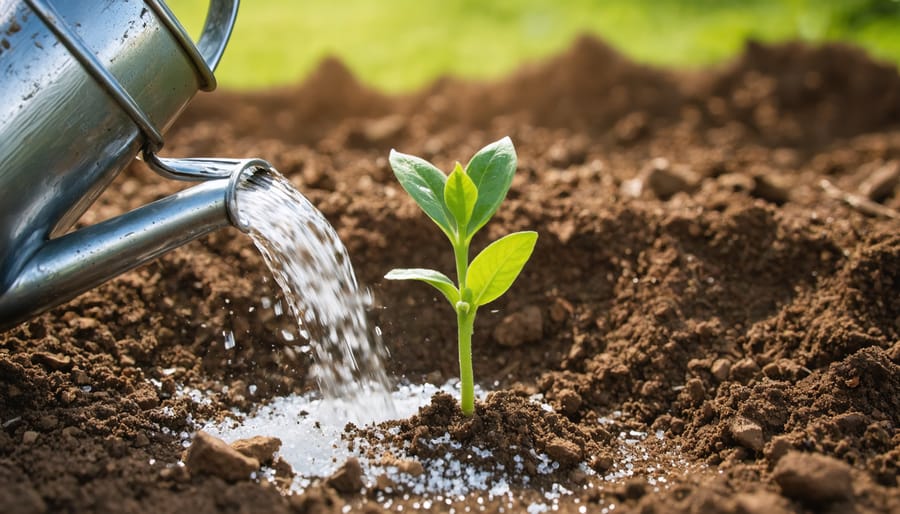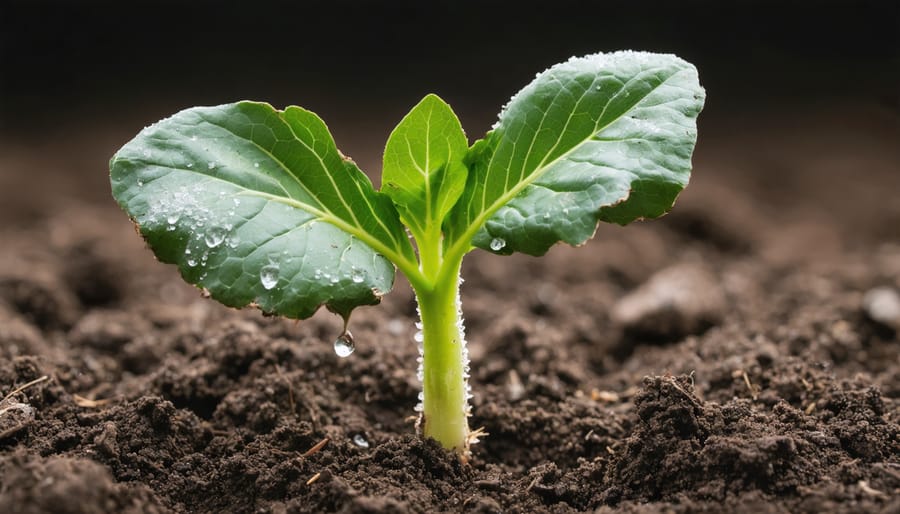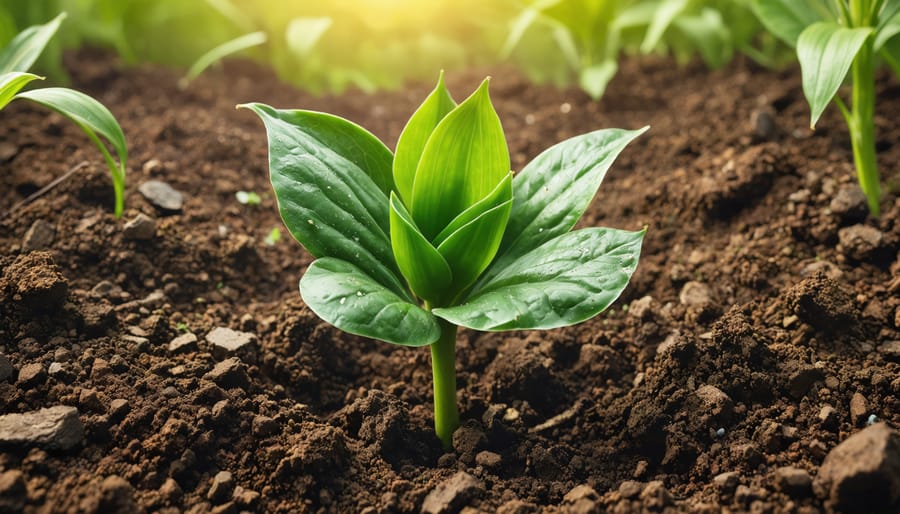Growing water-efficient crops isn’t just smart gardening—it’s becoming essential for sustainable food production. As climate patterns shift and water resources become increasingly precious, choosing plants that naturally thrive in dry conditions can make the difference between a thriving garden and a struggling one. These five drought-resistant crops don’t just survive with minimal water—they produce abundant harvests while helping conserve one of our most valuable resources. Whether you’re dealing with water restrictions, living in an arid climate, or simply want to garden more sustainably, these hardy plants offer practical solutions for growing food with less water. Let’s explore these remarkable crops that prove you don’t need endless irrigation to maintain a productive garden.
Growing Success with Less Water: Key Principles
Success in water-conscious gardening starts with understanding a few fundamental principles that can make a significant difference in your garden’s water consumption. By implementing smart water-efficient gardening techniques, you can create a thriving garden while conserving this precious resource.
First, focus on soil preparation. Rich, organic soil with plenty of compost helps retain moisture and reduces the need for frequent watering. Adding a layer of mulch around your plants can significantly decrease water evaporation and keep roots cool during hot weather.
Timing is everything when it comes to watering. Water early in the morning or late in the evening to minimize evaporation losses. Deep, infrequent watering encourages roots to grow deeper, making plants more resilient during dry spells.
Consider your garden’s layout carefully. Group plants with similar water needs together, making it easier to water efficiently. Creating slight depressions around plants helps direct water to the root zone where it’s needed most.
Choose native or well-adapted varieties whenever possible. These plants have naturally evolved to thrive in your local climate conditions and typically require less supplemental watering once established. Remember, healthy plants are more efficient at using water, so maintain good garden hygiene and address pest issues promptly.
Starting with these principles will set you up for success as you explore specific low-water crops for your garden.


Your Top Water-Saving Crops
Bush Beans: The Desert’s Friend
Bush beans are a gardener’s dream when it comes to water-efficient crops. These hardy plants typically need just 1 inch of water per week, making them perfect for areas with limited rainfall or water restrictions. What makes bush beans even more appealing is their quick maturity – you can harvest fresh pods in just 50-60 days from planting.
To get the most out of your bush beans while conserving water, plant them in well-draining soil enriched with compost. Space plants about 6 inches apart and mulch generously around them to retain moisture and prevent water evaporation. The best time to water is early morning, directing water at the base of the plants rather than overhead.
These resilient legumes not only save water but also improve your soil by fixing nitrogen. For maximum water efficiency, consider companion planting bush beans with other drought-tolerant plants like carrots or radishes. When you notice the first flowers appearing, maintain consistent (but not excessive) moisture to ensure good pod development.
As an added bonus, bush beans are self-pollinating and don’t require any special attention to produce a bountiful harvest. Just remember to harvest pods regularly to encourage continued production.
Swiss Chard: Your Hardy Green Champion
Swiss chard is your garden’s resilient superstar when it comes to water efficiency. This leafy green powerhouse can thrive with minimal irrigation once established, making it perfect for water-conscious gardeners. Its deep root system allows it to seek out moisture far below the soil surface, while its broad leaves help shade the soil and reduce evaporation.
What makes Swiss chard particularly special is its ability to bounce back even after periods of drought. While it prefers consistent moisture, it won’t throw in the towel if you miss a few waterings. For best results, plant your chard in well-draining soil enriched with organic matter, and space plants about 12 inches apart to give them room to develop those water-seeking roots.
One of the best features of Swiss chard is its cut-and-come-again nature. You can harvest the outer leaves throughout the growing season while leaving the center to continue producing new growth. This means you’ll get months of nutritious greens from the same water investment. A layer of mulch around your plants will help retain moisture and keep those beautiful leaves coming all season long.
Armenian Cucumbers: Cool Under Pressure
Despite their name, Armenian cucumbers aren’t actually cucumbers at all – they’re a variety of muskmelon that looks and tastes like a cucumber! These heat-loving champions are perfect for gardeners in dry regions, thanks to their remarkable drought tolerance and deep root system that efficiently seeks out available moisture.
What makes these plants truly special is their ability to keep producing crisp, refreshing fruits even when temperatures soar and water is scarce. Their long, ribbed fruits grow straighter and sweeter than traditional cucumbers, and they never develop the bitter taste that regular cucumbers can get under stress.
These resilient plants need about 30% less water than standard cucumber varieties, making them an excellent choice for water-conscious gardening. They thrive in well-draining soil and actually prefer less frequent, deeper watering over constant moisture. As an added bonus, their vigorous vines provide natural shade for the soil, helping to retain precious moisture and reduce overall water needs.
For best results, mulch around the base of the plants and water deeply at soil level rather than spraying the leaves. Your Armenian cucumbers will reward you with a bountiful harvest of crisp, mild-flavored fruits all summer long.
Tepary Beans: Ancient Wisdom for Modern Gardens
Tepary beans, a treasure from Native American agriculture, are nature’s answer to water-wise gardening. These remarkable legumes have sustained desert communities for thousands of years, thriving in conditions that would make other beans wilt. With their deep root systems and quick growth cycle, tepary beans can produce a bountiful harvest with as little as 6 inches of rainfall per season.
What makes these beans truly special is their adaptability. Once established, they actually prefer dry conditions and will produce sweet, protein-rich beans that are smaller than common varieties but pack more flavor. They’re perfect for gardeners in arid regions or anyone looking to reduce their garden’s water consumption.
To grow tepary beans successfully, plant them in well-draining soil when temperatures warm up in spring. Space plants about 6 inches apart and avoid overwatering – these beans are happiest when the soil dries out between waterings. You’ll be amazed at how these resilient plants thrive with minimal fuss, producing delicious beans that can be used in soups, stews, or traditional Southwest dishes.
Cherry Tomatoes: Small but Mighty
Cherry tomatoes are truly remarkable when it comes to water efficiency. These tiny powerhouses have evolved to thrive with less water than their larger cousins, thanks to their compact size and well-developed root systems. Their small fruits require less energy and water to develop, making them perfect for water-conscious gardeners.
These resilient plants have adapted to handle dry spells by developing deep roots that can seek out moisture even in challenging conditions. Once established, cherry tomatoes can produce an abundant harvest with about 40% less water than regular tomatoes. The key is to water them deeply but less frequently, encouraging those roots to grow deep into the soil.
For best results, mulch around your cherry tomatoes with straw or organic material to retain moisture and reduce evaporation. Plant them in well-draining soil and consider using drip irrigation to deliver water directly to the roots. Many gardeners find that cherry tomatoes actually develop more intense flavors when slightly water-stressed, as the plant concentrates its sugars and nutrients in the smaller fruits.
Success Tips for Water-Wise Cultivation
Success with water-wise crops starts with understanding your soil composition and implementing effective water-retention techniques. Begin by adding organic matter to your soil, which acts like a sponge to hold moisture where plants need it most. A 2-3 inch layer of mulch around your plants will significantly reduce water evaporation and keep roots cool.
Timing is everything when it comes to watering. Water deeply but less frequently to encourage deeper root growth, which helps plants become more drought-resistant. Early morning or evening watering reduces evaporation loss and gives plants time to absorb moisture before the heat of the day.
Consider companion planting to create beneficial microclimates. Taller plants can provide shade for shorter, more sensitive ones, while ground covers help retain soil moisture. Installing drip irrigation or soaker hoses delivers water directly to plant roots, minimizing waste and preventing leaf diseases that can develop with overhead watering.
Monitor your plants closely for signs of water stress, but don’t overreact to slight wilting during hot afternoons – this is normal, and plants often recover by morning. Yellowing leaves or stunted growth, however, may indicate adjustments are needed in your watering routine.
Remember to harvest regularly to encourage continued production and remove any weeds promptly, as they compete for precious water resources. With these mindful practices, you’ll be amazed at how little water you need to grow a thriving, productive garden.

Growing water-efficient crops is not just environmentally responsible – it’s also a smart gardening strategy that can help you maintain a thriving garden even during dry spells. The five crops we’ve explored – amaranth, cowpeas, chickpeas, quinoa, and millet – demonstrate that you don’t need excessive water to produce nutritious and delicious harvests.
These drought-resistant plants are perfect for gardeners in arid regions or anyone looking to reduce their water consumption. Each crop brings its unique benefits to your garden, from amaranth’s striking appearance to quinoa’s superfood status. Plus, they’re relatively low-maintenance, making them excellent choices for both novice and experienced gardeners.
Ready to get started? Begin with just one or two of these water-efficient crops and gradually expand your drought-resistant garden. Remember to prepare your soil well, mulch appropriately, and water deeply but infrequently to encourage strong root development. With these resilient plants in your garden, you’ll be contributing to water conservation while enjoying fresh, homegrown produce.
Why not make this growing season the one where you try something new? Your garden – and the environment – will thank you for it!




